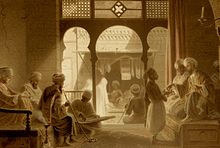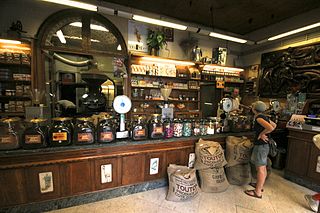
Italians are well known for their special attention to the preparation, the selection of the blends, and the use of accessories when creating many types of coffees. Many of the types of coffee preparation known today also have their roots here. The main coffee port in Italy is Trieste where there is also a lot of coffee processing industry. Italian coffee consumption, often espresso, is highest in the city of Trieste, with an average of 1500 cups of coffee per person per year. That is about twice as much as is usually drunk in Italy.
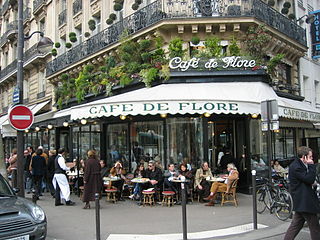
A coffeehouse, coffee shop, or café is an establishment that primarily serves various types of coffee, espresso, latte, and cappuccino. Some coffeehouses may serve cold drinks, such as iced coffee and iced tea, as well as other non-caffeinated beverages. A coffeehouse may also serve food, such as light snacks, sandwiches, muffins, fruit, or pastries. In continental Europe, some cafés also serve alcoholic beverages. Coffeehouses range from owner-operated small businesses to large multinational corporations. Some coffeehouse chains operate on a franchise business model, with numerous branches across various countries around the world.

Turkish coffee is a style of coffee prepared in a cezve using very finely ground coffee beans without filtering.

Coffee is a beverage brewed from roasted coffee beans. Darkly colored, bitter, and slightly acidic, coffee has a stimulating effect on humans, primarily due to its caffeine content. It has the highest sales in the world market for hot drinks.

White coffee can refer to any of a number of different kinds of coffees or coffee substitutes worldwide.
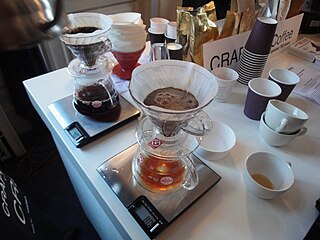
Coffee preparation is the process of turning coffee beans into liquid coffee. While the particular steps vary with the type of coffee and with the raw materials, the process includes four basic steps: raw coffee beans must be roasted, the roasted coffee beans must then be ground, and the ground coffee must then be mixed with hot or cold water for a specific time (brewed), the liquid coffee extraction must be separated from the used grounds, and finally, if desired, the extracted coffee is combined with other elements of the desired beverage, such as sweeteners, dairy products, dairy alternatives, or toppings.

Yemeni cuisine is distinct from the wider Middle Eastern cuisines, but with a degree of regional variation. Although some foreign influences are evident in some regions of the country, the Yemeni kitchen is based on similar foundations across the country.
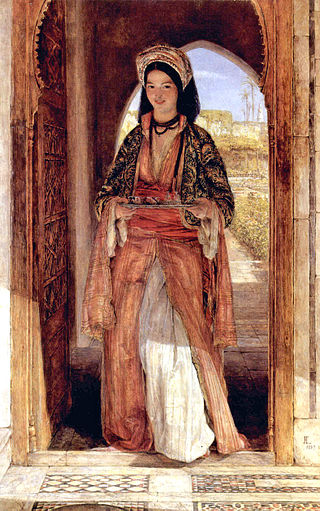
The history of coffee dates back to centuries of old oral tradition in modern-day Somalia, Ethiopia and Yemen. It was already known in Mecca in the 15th century. Also, in the 15th century, Sufi monasteries in Yemen employed coffee as an aid to concentration during prayers. Coffee later spread to the Levant in the early 16th century; it caused some controversy on whether it was halal in Ottoman and Mamluk society. Coffee arrived in Italy the second half of the 16th century through commercial Mediterranean trade routes, while Central and Eastern Europeans learned of coffee from the Ottomans. By the mid 17th century, it had reached India and the East Indies.

Coffee culture is the set of traditions and social behaviors that surround the consumption of coffee, particularly as a social lubricant. The term also refers to the cultural diffusion and adoption of coffee as a widely consumed stimulant. In the late 20th century, espresso became an increasingly dominant drink contributing to coffee culture, particularly in the Western world and other urbanized centers around the globe.

Jebena is a traditional Ethiopian and Eritrean flask made of pottery and used to brew Arabic coffee. It is also widely used in Sudan, and the coffee itself is called bunna.

Saudi Arabian cuisine varies according to the diverse landscapes and regions of the country. The environmental, geographic, and cultural diversity within this vast area has led to a wide variety of dishes. Saudi Arabia encompasses different regions, resulting in cuisines from the Central region, Eastern, Southern and Western regions. Furthermore, Saudi Arabia's position along global trade routes has led to the introduction of various spices. As home to the Muslim holy cities of Mecca and Medina, which millions of people visit annually.
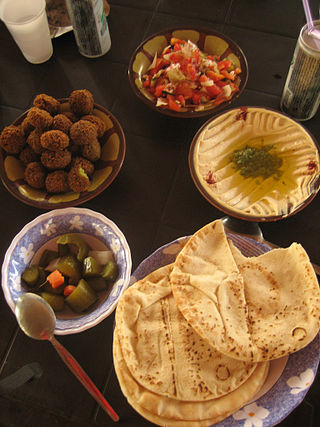
Jordanian cuisine is a Levantine cuisine developed over time in Jordan. Stuffed vegetables are common, with many different techniques employed in their preparation. Meat is an important component of Jordanian cuisine, most often lamb, beef and chicken but also goat and camel meat. Rice is frequently served as a side dish but there are also one-pot rice dishes such as maqloubah.

A dallah is a traditional Arabic coffee pot used for centuries to brew and serve Qahwa (gahwa), an Arabic coffee or Gulf coffee made through a multi-step ritual, and Khaleeji, a spicy, bitter coffee traditionally served during feasts like Eid al-Fitr.
Seattle is regarded as a world center for coffee roasting and coffee supply chain management. Related to this, many of the city's inhabitants are coffee enthusiasts; the city is known for its prominent coffee culture and numerous coffeehouses.

Qatari cuisine is made up of traditional Arab cuisine. Machbūs, a meal consisting of rice, meat, and vegetables, is the national dish in Qatar, typically made with either lamb or chicken and slow-cooked to give it a depth of flavour. Seafood and dates are staple food items in the country. Many of these dishes are also used in other countries in the region, because they share many commonalities. In other parts of the region some of the dishes have different names or use slightly different ingredients. One proponent of the importance of Qatar's culinary heritage is chef Noor Al Mazroei, who adapts traditional recipes to include vegan and gluten-free alternatives.
Mırra is a traditional type of bitter coffee prepared in the Hatay, Adana, Urfa and Mardin provinces of Turkey, as well as in some Arab countries like Lebanon and Syria, which is also sometimes correctly referred to as Arabic coffee because the name is derived from Arabic; mur meaning bitter. Since it is very bitter and dark, it is served in tiny cups without handles similar in size to Italian espresso cups. The coffee beans for Mırra are common coffea arabica coffee beans that are roasted twice to increase the bitter taste. They are ground so that they are still grainy, unlike Turkish coffee, which is more like a powder. The coffee is put into a narrow-topped small boiling pot called cezve, and water is added, usually accompanied by some cardamom to give a more aromatic flavour.
Countries have cultivated coffee beans into various vehicles to satisfy needs unique to each country. Whether it be for energy, socialization, or tradition, the cultivation of coffee has served as a motivating force of the world. The modernization of coffee and its unique forms across cultures are markers of tradition and modern changes across continents. Coffee culture appears in the way in which people consume coffee, the way they make it, and where coffee is served and shared. Each of these factors combined reflects the lives of the people in these countries and the importance of coffee across the world.

Arabic tea (Arabic: شاي عربي, romanized: šāy ʿarabiyy, (pronounced shay, is a variety of hot teas popular throughout the Arab world. It is commonly served to guests and business partners at meetings and social events, and has been drunk by Arab people for centuries.







